NEW LEARNET EDUCATION
Chapter 8 -: Motion (Handwritten Extra Questions)
PART - 1
Motion Class 9 Extra Questions Very Short Answer Questions
Question 1.
The phenomenon of motion was placed on a sound scientific footing by two scientists. Write their names.
Answer:
Galileo Galilei and Isaac Newton.
Question 2.
Are rest and motion absolute or relative terms?
Answer:
They are relative terms.
Question 3.
Suppose a ball is thrown vertically upwards from a position P above the ground. It rises to the highest point Q and returns to the same point P. What is the net displacement and distance travelled by the ball?
Answer:
Displacement is zero. Distance is twice the distance between position P and Q.
Question 4.
Which speed is greater: 30 m/s or 30 km/h?
Answer:
30 m/s
Question 5.
What do you mean by 2 m/s2?
Answer:
The velocity of the body increases by 2 m/s after every second.
Question 6.
Can uniform linear motion be accelerated?
Answer:
No
Question 7.
Define one radian.
Answer:
It is the angle which is subtended at the centre by an arc having a length equal to the radius of the circle.
Question 8.
What is the relation between linear velocity and angular velocity?
Answer:
Linear velocity = Angular velocity × Radius of circular path.
Question 9.
Give an example when we infer the motion indirectly.
Answer:
We infer the motion of air by observing the movement of dust particles or leaves and branches of trees, or simply by feeling the blowing air on our face.
Question 10.
What is essential to describe the position of an object?
Answer:
We need to specify a reference point called the origin.
Question 11.
What is the simplest type of motion?
Answer:
Motion in a straight line.
Question 12.
What indicates the motion of the earth?
Answer:
The phenomenon like day and night indicates the motion of the earth.
Question 13.
If the displacement of a body is zero, is it necessary that the distance coyered by it is also zero?
Answer:
No. When the body comes back to the same position after travelling a distance, its displacement is zero though it has travelled some distance.
Question 14.
Can the displacement be greater than the distance travelled by an object?
Answer:
No, it is always either equal to or less than the distance travelled by the object.
Question 15.
When do the distance and displacement of a moving object have the same magnitude?
Answer:
The magnitude of distance and displacement of a moving object are same when the object moves along the same straight line in the same fixed direction.
Question 16.
Does the speedometer of a car measure its average speed?
Answer:
No. It measures its instantaneous speed.
Question 17.
A body is moving with a velocity of 10 m/s. If the motion is uniform, what will be the velocity after 10 s?
Answer:
As the motion is uniform, the velocity remains 10 m/s after 10 s.
Question 18.
Can a body have constant speed but variable velocity?
Answer:
Yes, e.g. a body in uniform circular motion has constant speed but due to the change in the direction of motion, its velocity changes at every point.
Question 19.
When is the acceleration taken as negative?
Answer:
Acceleration is taken as negative if it is in the direction opposite to the direction of velocity.
Question 20.
What is uniform acceleration?
Answer:
Acceleration of an object is said to be uniform if it travels in a straight line and its velocity increases or decreases by equal amounts in equal intervals of time.For example, motion of a freely falling body.
Question 21.
Give an example of non-uniform acceleration.
Answer:
A car is travelling along a straight road increases its speed by unequal amounts in equal intervals of time.
Question 22.
How are the distances travelled by an object related to the time taken when an object travels equal distances in equal intervals of time?
Answer:
In this case, distance travelled by the object is directly proportional to the time taken.
Question 23.
What would be acceleration of a body if its velocity-time graph is a line parallel to the time axis?
Answer:
Zero, as the body possesses uniform velocity.
Question 24.
Is the motion of a body uniform or accelerated if it goes round the sun with constant speed in a circular orbit?
Answer:
It is accelerated, as its velocity changes due to change in direction.
Motion Class 9 Extra Questions Short Answer Questions-I
Question 1.
Give an example of a body which may appear to be moving for one person and stationary for the other.
Answer:
The passengers in a moving bus observe that the trees, buildings as well as the people on the roadside appear to be moving backwards. Similarly, a person standing on the roadside observes that the bus (along with its passengers) is moving in forward direction. But, at the same time, each passenger in a moving bus or train observes, his fellow passengers sitting and not moving. Thus, we can tell that motion is relative.
Question 2.
How can we describe the location of an object?
Answer:
To describe the position of an object we need to specify a reference point called the origin.
For example, suppose that a library in a city is 2 km north of the railway station. We have specified the position of the library with respect to the railway station i.e., in this case, the railway station acts as the reference point.
Question 3.
What do you mean by average speed? What are its units?
Answer:
Average speed is defined as the average distance travelled per unit time and is obtained by dividing the total distance travelled by the total time taken.
The unit of average speed is the same as that of the speed, that is, ms-1.
Question 4.
What is the difference between uniform velocity and non-uniform velocity?
Answer:
Uniform velocity: An object with uniform velocity covers equal distances in equal intervals of time in a specified direction, e.g., an object moving with speed of 40 kmh-1 towards west has uniform velocity.
Non-uniform velocity: When an object covers unequal distances in equal intervals of time in a specified direction, or if the direction of motion changes, it is said to be moving with a non-uniform or variable velocity, e.g., revolving fan at a constant speed has variable velocity.
Question 5.
What do you understand by instantaneous velocity?
Answer:
Instantaneous velocity is the velocity of a body at any particular instant during its motion. For example, the instantaneous velocity of a motorcycle at a particular instant is 40 kmh-1 if it is moving at 40 kmh-1 at that particular instant. It is measured by the speedometers on the vehicles.
Question 6.
What is negative acceleration?
Answer:
If the velocity of a body decreases with time, then its final velocity is less than the initial velocity and thus its acceleration is negative. Negative acceleration is called retardation or deceleration. For example, when brakes are applied to a moving truck, its velocity gradually decreases. In other words, it is under retardation.
Question 7.
How will the equations of motion for an object moving with a uniform velocity change? [NCERT Exemplar]
Answer:
Acceleration a = 0, v = u
So, the equations of motion will become
s = ut
v2 – u2 = 0
Question 8.
Express average velocity when the velocity of a body changes at a non-uniform rate and a uniform rate.
Answer:
When the velocity of a body changes at a non-uniform rate, its average velocity is found by dividing the net displacement covered by the total time taken.
i.e., Average velocity =
In case the velocity of a body changes at a uniform rate, then the average velocity is given by the arithmetic mean of initial velocity and final
i.e., Average velocity =
Question 9.
A particle is moving in a circular path of radius r. What would be the displacement after half a circle?
Answer:
Displacement = AB
= Shortest distance between initial and final positions
= r + r = 2r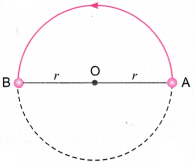
Motion Class 9 Extra Questions Short Answer Questions-II
Question 1.
Differentiate between distance and displacement.
Answer:
Question 2.
What are the uses of a distance-time graph?
Answer:
The various uses of a distance-time graph are as follows:
- It tells us about the position of the body at any instant of time.
- From the graph, we can see the distance covered by the body during a particular interval of time.
- It also gives us information about the velocity of the body at any instant of time.
Question 3.
Draw a velocity versus time graph of a stone thrown vertically upwards and then coming downwards after attaining the maximum height. [NCERT Exemplar]
Answer:
During upward motion, acceleration = -g and during downward motion acceleration = + g. Times of upward and downward motion is equal. Also initial and final velocities are equal to 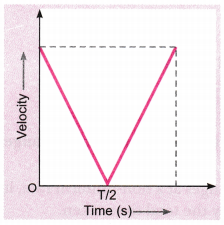
Question 4.
The data regarding the motion of two different objects P and Q is given in the following table. Examine them carefully and state whether the motion of the objects is uniform or non-uniform.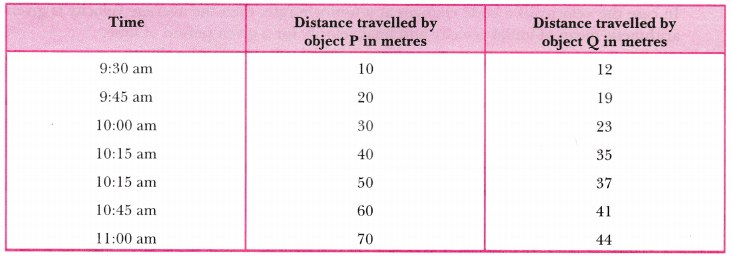
Answer:
We can see that the object P covers a distance of 10 m in every fifteen minutes. In other words, it covers equal distance in equal interval of time. So, the motion of object P is uniform. On the other hand, the object Q covers 7 m from 9:30 am to 9:45 am, 4 m from 9:45 am to 10:00 am, and so on. In other words, it covers unequal distance in equal interval of time. So, the motion of object Q is non-uniform.
Question 5.
How will you show that the slope of displacement-time graph gives velocity of the body ?
Answer: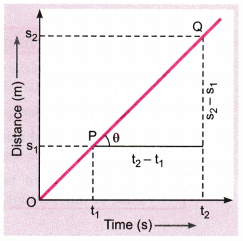
The adjoining figure shows the displacement-time graph for a body moving with uniform velocity. Clearly, it covers distance s1 and s2 at times t1 and t2 respectively.
Slope of line PQ = tanθ =
=
As
Question 6.
What are the characteristics of distance-time graph for an object moving with a non-uniform speed?
Answer:
The characteristics of distance-time graph for a non-uniform speed are: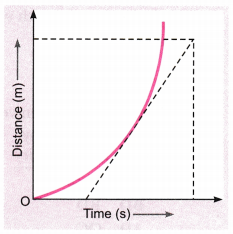
- It is always a curve (parabola).
- The speed of the moving object at any point is given by the slope of the tangent to the curve at that point.
Question 7.
Given below is the velocity-time graph for the motion of the car. What does the nature of the graph show ? Also find the acceleration of the car.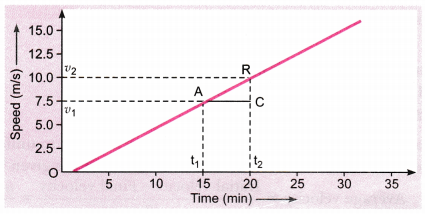
Answer:
The nature of the graph shows that velocity changes by equal amounts in equal intervals of time. For a uniformly accelerated motion, velocity-time graph is always a straight line.
As we know, acceleration is equal to the slope of the graph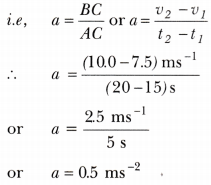
Motion Class 9 Extra Questions Long Answer Questions
Question 1.
With the help of a graph, derive the relation v = u + at.
Answer:
Consider the velocity-time graph of an object that moves under uniform acceleration as shown in the figure (u ≠ 0).
From this graph, we can see that initial velocity of the object (at point A) is u and then it increases tow (at point B) in time t. The velocity changes at a uniform rate a. As shown in the figure, the lines BC and BE are drawn from point B on the time and the velocity axes respectively, so that the initial velocity is represented by OA, the final velocity is represented by BC and the time interval t is represented by OC. BD = BC – CD, represents the change in velocity in time interval t.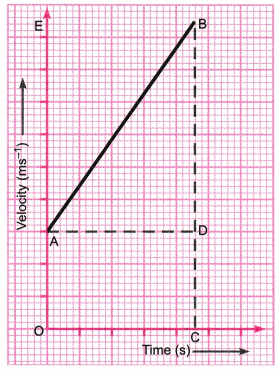
If we draw AD parallel to OC, we observe that
BC = BD + DC = BD + OA
Substituting, BC with v and OA with u,
we get
v = BD + u
or BD = v – u …(1)
Thus, from the given velocity-time graph, the acceleration of the object is given by
a =
=
Substituting, OC with t, we get
a =
From equations (1) and (2),
we have
v – u = at or v = u + at
Question 2.
Deduce the following equations of motion:
(i) s = ut +
(ii) v2 = u2 + 2as
Answer:
(i) Consider a body which starts with initial velocity u and due to uniform acceleration a, its final velocity becomes v after time t. Then, its average velocity is given by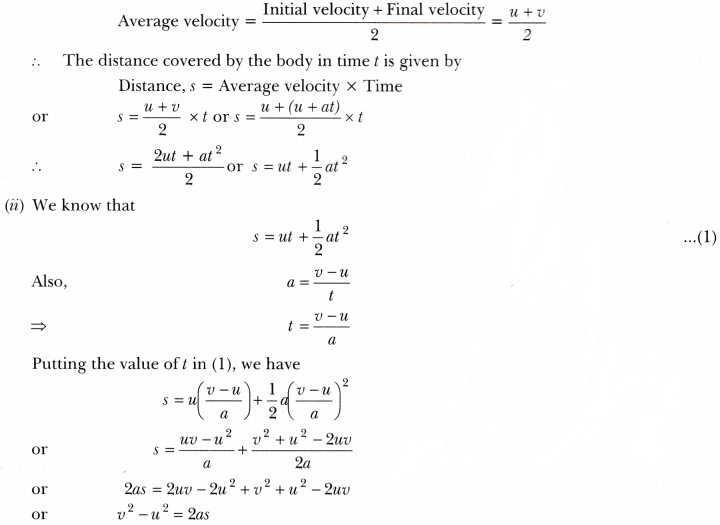
Question 3.
Obtain a relation for the distance travelled by an object moving with a uniform acceleration in the interval between 4th and 5th seconds. [NCERT Exemplar]
Answer:
Using the equation of motion s = ut +
Distance travelled in 5 seconds, s = u × 5 +
or s = 5u +
Similarly, distance travelled in 4 seconds, s’ = 4u +
Distance travelled in the interval between 4th and 5th seconds
= (s – s’) = (u +
Question 4.
Two stones are thrown vertically upwards simultaneously with their initial velocities u] and w2 respectively. Prove that the heights reached by them would be in the ratio of
(Assume upward acceleration is —g and downward acceleration to be +g). [NCERT Exemplar]
Answer: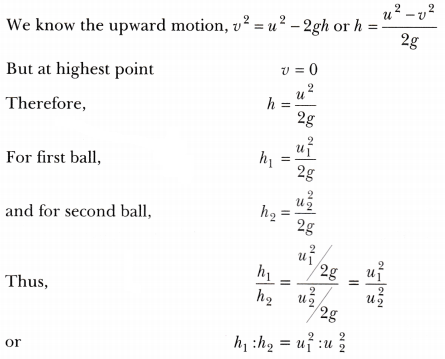
Question 5.
The driver of train A travelling at a speed of 54 kmh-1 applies brakes and retards the train uniformly. The train stops in 5 seconds. Another train B is travelling on the parallel with a speed of 36 kmh-1. Its driver applies the brakes and the train retards uniformly; train B stops in 10 seconds. Plot speed-time graphs for both the trains on the same axis. Which of the trains travelled farther after the brakes were applied?
Answer:
For train A, the initial velocity,
u = 54 kmh-1 = 54 ×
Final velocity, v = 0 and time, t = 5 s
For train B, u = 36 kmh– 1 = 36 ×
v = 0; t = 10 s
Speed-time graph for train A and B are shown in the figure.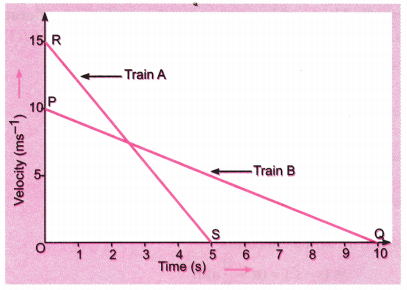
Distance travelled by train A
= Area under straight line graph RS
= Area of ∆ORS
=
Distance travelled by train B = Area under PQ = Area of ∆OPQ
=
Thus, train B travelled farther after the brakes were applied.
Numericals
Question 1.
Study the speed-time graph of a body given here and answer the following questions: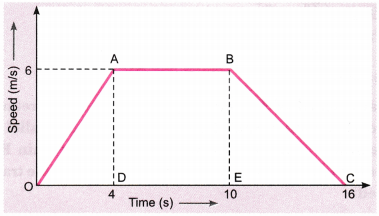
(a) What type of motion is represented by OA?
(b) What type of motion is represented by AB?
(c) What type of motion is represented by BC?
(d) Find out the acceleration of the body.
(e) Calculate the retardation of the body.
(f) Find out the distance travelled by the body from A to B.
Answer:
(a) OA is a straight line graph between speed and time, and it is sloping upward from O to A. Therefore, the graph line OA represents uniform acceleration.
(b) AB is a straight line graph between speed and time, which is parallel to the time axis (x-axis).
So, AB represents uniform speed. There is no acceleration from A to B.
(c) BC is a straight line graph between speed and time which is sloping downwards from B to C. Therefore, BC represents uniform retardation or negative acceleration.
(d) Acceleration of the body as we see from graph line OA represents it. So, the slope of velocity-time graph OA will give the acceleration of the body. Thus,
Acceleration = Slope of line OA = AD/OD
We have, AD = 6 m/s, and OD = 4 s
So, acceleration =
(e) The slope of line graph BC represents the retardation of the body.
So, retardation = Slope of line BC = BE/EC
We have, BE = 6m/s, EC = 16 – 10 = 6s
Retardation =
(f) Distance travelled from A to B = Area under the line AB and the time axis
= Area of rectangle DABE = DA × DE
Here, DA = 6 m/s and DE = 10 – 4 = 6 s
Distance travelled from A to B = 6 × 6 = 36m
Question 2.
The graph given below shows the positions of a body at different times. Calculate the speed of the body as it moves from
(i) A to B
(ii) B to C and
(iii) C to D.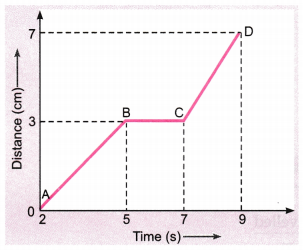
Answer:
(i) The distance-time graph represents the line AB which shows the speed of the body. So,
Speed =
(ii) The distance-time graph shows that the body is at rest between graph line B to C, it means no movement. So speed is zero i.e.,
Speed =
(iii) The distance-time graph represents the line CD which shows the speed of the body. So,
Speed =
Question 3.
Distance travelled by a train and time taken by it is shown in the following table, (i) Plot distance-time graph. (ii) What is the average speed of the train? (iii) When is the train travelling at the highest speed? (iv) At what distance does the train slow down? (v) Calculate the speed of the train between 10:40 AM to 11:00 AM.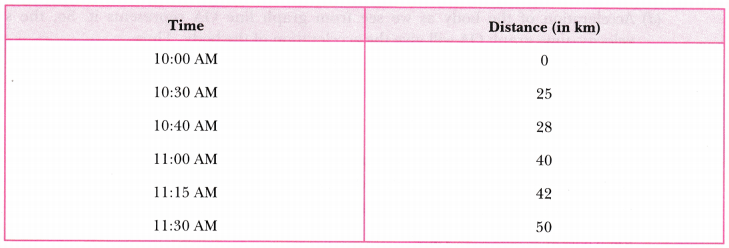
Answer: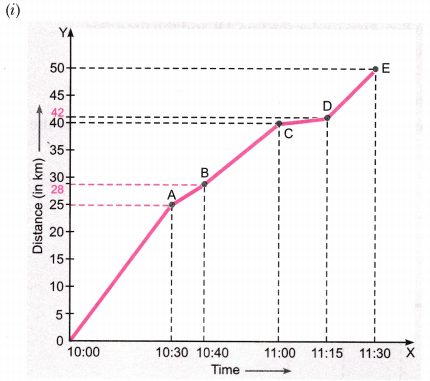
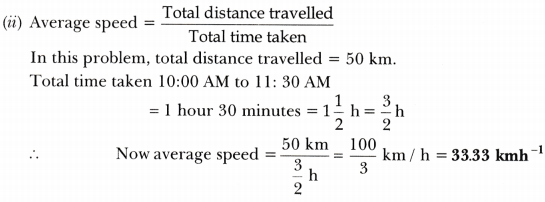
(iii) We know, speed = slope of distance-time graph. The greater the slope, the greater is the speed.
From the graph, it is clear that slope of distance-time graph is maximum between 10:00 AM to 10:30 AM, so the train was travelling at the highest speed during this interval of time.
(iv) The part CD of the graph has minimum slope, so the train had minimum speed between 11:00 AM and 11:15 AM. Thus, the train had slowed down between 40 km and 42 km.
(v) Speed between 10:40 AM to 11:00 AM =
Question 4.
The velocity-time graph shows the motion of a cyclist. Find (i) its acceleration (ii) its velocity and (iii) the distance covered by the cyclist in 15 seconds. [NCERT Exemplar]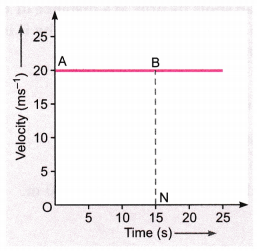
Answer:
(i) Since velocity is not changing acceleration is equal to zero. [a =
(ii) Reading the graph, velocity = 20 ms-1 (constant)
(iii) Distance covered in 15 seconds = Area of ABNO
= v × t
= 20 × 15 = 300 m
Question 5.
A body starts to slide over a horizontal surface with an initial velocity of 0.5 m/s. Due to friction, its velocity decreases at the rate 0.05 m/s2. How much time will it take for the body to stop?
Answer:
Initial velocity, u = 0.5 m/s
Final velocity, v= 0
Acceleration, a = -0.05 m/s2
Now, from the first equation of the motion,
v = u + at
or, 0 = 0.5 + (- 0.05t) ⇒ 0.5 = 0.05t,
∴ t = 0.5/0.05 = 10 s
Thus, the body will take 10 s to stop.
Question 6.
A particle moves in a circle with O as centre and AO = OB = 5 cm, as radius, as shown in the figure. It starts from A. Calculate:
(a) the distance covered, and
(b) the displacement, when it reaches B.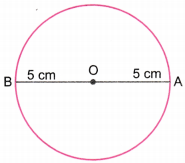
Answer:
(a) Distance covered = π × OA = π × 5 = 5π cm
(b) Displacement = 2 × OB
= 2 × 5 = 10 cm along AB
Question 7.
A body travels along a circular path of radius 70 m. After travelling half a revolution in 20 s, find the
(i) average velocity,
(ii) average speed.
Answer:

Question 8.
A cheetah is the fastest land animal and can achieve a peak velocity of 100 km/h up to distances less than 500 m. If a cheetah spots its prey at a distance of 100 m, what is the minimum time it will take to get its prey, if the average velocity attained by it is 90 km/h?
Answer:
Average velocity = 90 km/h =
=
Also, Average velocity =
∵ Cheetah moves in a straight line displacement is equal to 100 m.
Therefore, time taken =
Question 9.
The brakes applied to a car produce an acceleration of 6 ms-2 in the opposite direction to the motion. If the car takes 2s to stop after the application of brakes, calculate the distance it travels during this time.
Answer:
We have been given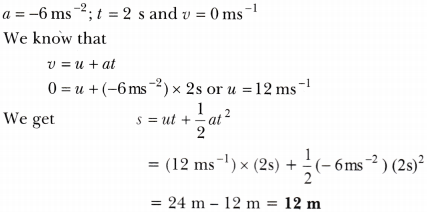
Thus, the car will move 12 m before it stops after the application of brakes.
Question 10.
A car starts from rest and moves along the x-axis with constant acceleration 5 ms-2 for 8 seconds. If it then continues with constant velocity, what distance will the car cover in 12 seconds since it started from the rest? [NCERT Exemplar]
Answer:
Initial velocity ,u = 0
Using s = ut +
The distance travelled in first 8s,
s1 = 0 +
At this point the velocity, v = u + at
= 0 + 5 × 8 = 40 ms-1
So, the distance covered in last four seconds
s2 = 40 × 4 = 160 m
Hence, total distance, s = s1 + s2
= 160 m + 160 m = 320 m
Question 11.
A motorcyclist drives from A to B with a uniform speed of 30 kmh-1 and returns back with a speed of 20 kmh-1. Find its average speed. [NCERT Exemplar]
Answer:
Question 12.
An object is dropped from rest at a height of 150 m and simultaneously another object is dropped from rest at a height 100 m. What is the difference in their heights after 2 s if both the objects drop with same accelerations? How does the difference in heights vary with time? [NCERT Exemplar]
Answer:
Initial difference in height = (150 – 100) m = 50 m
Distance travelled by first body in 2 s = h1 = 0 +
Distance travelled by another body in 2 s = h2 = 0 +
After 2 s, height at which the first body will be = h1‘ = 150 – 2g
After 2 s, height at which the second body will be = h’2 = 100 – 2g
Thus, after 2 s, difference in height = 150 – 2g – (100 – 2g) = 50 m = initial difference in height Thus, difference in height does not vary with time.
Question 13.
An object starting from rest travels 20 m in first 2s and 160 m in next 4s. What will be the velocity after 7s from the start? [NCERT Exemplar]
Answer:
s1 = ut +
v = u + at = 0 + (10 × 2) = 20 ms-1
s2 = 160 = vt’ +
Since accelerations is the same, we have v’ = 0 + (10 × 7) =70 ms-1
Question 14.
An electron moving with a velocity of 5 × 104 ms-1 enters into a uniform electric field and acquires a uniform acceleration of 104 ms-2 in the direction of its initial motion.
(i) Calculate the time in which the electron would acquire a velocity double of its initial velocity.
(ii) How much distance the electron would cover in this time? [NCERT Exemplar]
Answer:
Given initial velocity, u = 5 × 104 ms-1
and acceleration, a = 104ms-2
(i) Final velocity = v = 2u = 2 × 5 × 104ms-1 = 10 × 104ms-1
To find t, use v = u + at
Motion Class 9 Extra Questions HOTS (Higher Order Thinking Skills)
Question 1.
Four cars A, B, C and D are moving on a levelled road. Their distance versus time graphs are shown in figure. Which car is the slowest?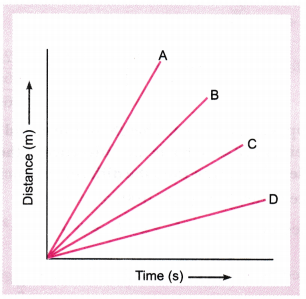
Answer:
Speed = Slope of distance-time graph. The smaller the slope, the smaller is the speed.
From the figure, slope is minimum for car D. So, D is the slowest car.
Question 2.
A girl walks along a straight path to drop a letter in the letterbox and comes back to her initial position. Her displacement-time graph is shown in figure. Plot a velocity-time graph for the same. [NCERT Exemplar]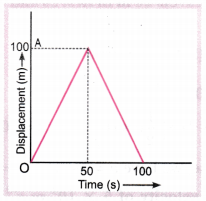
Answer:
Velocity from 0 to 50 s is v1 =
At 50 – 0
Velocity from 50 s to 100 s, v2 =
Accordingly the velocity-time graph is shown in figure below.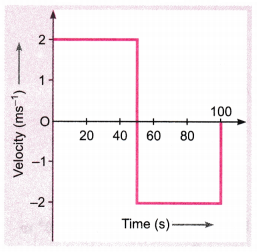
Question 3.
Suppose a squirrel is moving at a steady speed from the base of a tree towards some nuts. It then stays in the same position for a while, eating the nuts, before returning to the tree at the same speed. A graph can be plotted with distance on the x-axis and the time on y-axis.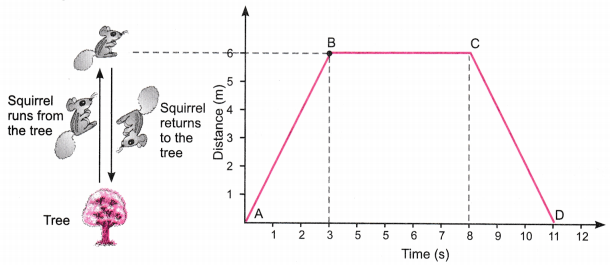
Observe the graph carefully and answer the following questions.
(i) Which part of the graph shows the squirrel moving away from the tree?
(ii) Name the point on the graph which is 6 m away from the base of the tree.
(iii) Which part of the graph shows that the squirrel is not moving?
(iv) Which part of the graph shows that the squirrel is returning to the tree?
(v) Calculate the speed of the squirrel from the graph during its journey.
Answer:
(i) Part AB
(ii) Part B
(iii) Part BC
(iv) Part CD
(v) Total distance travelled = 6m + 6m=12m
Time = 11 s.
Speed =
Question 4.
The table given below shows distance (in cm) travelled by bodies A, B and C. Read this data carefully and answer the following questions.
(i) Which of the bodies is moving with
(a) constant speed?
(b) constant acceleration?
(c) non-uniform acceleration?
(ii) Which of the bodies covers
(a) maximum distance in 3rd second?
(b) minimum distance in 3rd second?
Answer:
(i) (a) Body A (b) Body C (c) Body B
(ii) (a) Body C. Total distance travelled = 100 – 60 = 40 cm
(b) Body B. Total distance travelled = 24 – 36 = (-) 12 cm
The negative sign implies decceleration.
----------------------------------------------------------------------------------------------------------------------------------------------------------------------------------------------------------------------------------------------------------
PART - 2
Motion Class 9 Extra Questions Very Short Answer Type
Question 1.
Define the following terms:
(a) Distance
(b) Displacement
(c) Speed
(d) Velocity
(e) Acceleration
(f) Uniform motion
(g) Uniform circular motion
(h) Scalar quantity
(i) Vector quantity
Answer:
(a) Distance: The total path length traveled by a body in a given interval of time is called distance.
(b) Displacement: The shortest distance measured from the initial to the final position of an object is known as displacement.
(c) Speed: The speed of a body is defined as the distance traveled per unit time.
(d) Velocity: Velocity is defined as displacement per unit time.
(e) Acceleration: The rate of change of velocity with respect to time.
(f) Uniform motion: A body moving in a straight line has a uniform motion if it travels the equal distance in equal intervals of tune.
(g) Non-uniform motion: A body has a non-uniform motion if it travels unequal distances in equal intervals of time.
(h) Scalar quantity: A physical quantity which is described completely by its magnitude only, is called a scalar quantity.
(i) Vector quantity: A physical quantity that has magnitude as well as direction and obeys the vector addition is called a vector quantity.
Question 2.
Draw position-time graph of a body that started from a position other than origin and moving with uniform speed.
Answer: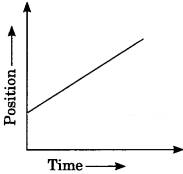
Question 3.
Give one example where the displacement is zero but the distance traveled is not zero.
Answer:
When a body completes one rotation in a circular path its initial and final positions are the same and hence its displacement is zero.
Question 4.
The area under the velocity-time curve represents which physical quantity?
Answer:
Distance and displacement.
Question 5.
Under what conditions, distance, and magnitude of the displacement are equal?
Answer:
Distance and displacement are equal fan object move along a straight line in one direction.
Question 6.
What is the numerical ratio of average velocity to the average speed of an object when it is moving in a straight path?
Answer:
In this case, both are equal, so the ratio is 1.
Question 7.
What does the speedometer of an automobile measure?
Answer:
The speedometer of a vehicle measures its instantaneous speed.
Question 8.
Classify the following quantities on the basis of scalar quantities and vector quantities.
(a) Distance
(b) Displacement
(c) Speed
(d) Velocity
(e) Acceleration
Answer:
(a) Distance: Scalar quantity
(b) Displacement: vector quantity
(c) Speed: Scalar quantity
(d) Velocity: Vector quantity
(e) Acceleration: Vector quantity
Question 9.
An object starts with initial velocity y and attains a final velocity y. The velocity is changing at a uniform rate. What is the formula for calculating average speed in this situation?
Answer:![]()
Question 10.
What will you say about the motion of an object if its distance-time graph is a straight line with having a constant angle with a time axis?
Answer:
The motion of the body is uniform motion (constant speed).
Question 11.
What will you say about the motion of a body if its velocity-time graph is a straight line parallel to the time axis?
Answer:
The velocity of the body is constant.
Question 12.
A physical quantity measured is -20 ms-1 It is speed or velocity?
Answer:
It is velocity because velocity can be positive or negative while speed cannot be negative.
Question 13.
A motorcycle drives from A to B with a uniform speed of 30 kmh1 and returns hack with a speed of 20 kmh1. Find its average speed.
Answer:
Let distance AB = x km.
Time taken from going A to B; t1 =
Time taken from goingBto A; t2 =
Total time taken,t = t1 + t2 =
total distance = x + x = 2x km
∴ Average speed = 24 km/h
Question 14.
A man swims in a pool of width 300 m. He covers 600 m in 10 minutes by swimming from on end to the other, and back along the same path. Find the average speed and average velocity of the man for the entire journey.
Answer:
Total distance covered by the man in 10 minutes = OA + AB = 600 m
Displacement of man in 10 minutes = 0 m![]()
Average speed = 1 m/s![]()
Average velocity = 0 m/s
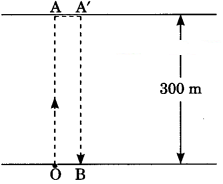
Question 15.
What is the acceleration of a body moving with uniform velocity along a straight line?
Answer:
Acceleration of the body is zero as the velocity is constant.
Question 16.
Give an example of a uniform circular motion.
Answer:
An athlete running on a circular track with constant speed.
Question 17.
Convert speed 54 km in meter per second.
Answer:
Speed = 54 km/h =54 x
Question 18.
What ¡s the nature of the distance-time graph for accelerated motion?
Answer: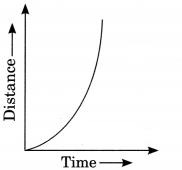
Motion Class 9 Extra Questions Short Answer Type 1
Question 1.
Distinguish between speed and velocity.
Answer:
Speed:
- Speed is the ratio of distance and time.
- Speed is always positive
- Speed is a scalar quantity.
Velocity:
- Velocity is the ratio of displacement and time.
- Velocity may be negative or positive.
- Velocity is a vector quantity.
Question 2.
Distinguish between distance and displacement.
Answer:
Distance
- It is the actual length of the path covered by a moving body.
- It is always positive or zero.
- It is a scalar quantity.
Displacement:
- It is the shortest distance measured between the initial and final positions.
- It may be positive, negative, or zero.
- it is a vector quantity.
Question 3.
Write down the SI unit of the following quantities:
(a) Displacement
(b) Speed
(c) Velocity
(d) Acceleration
Answer:
(a) m
(b) m/s
(c) m/s
(d) m/s2
Question 4.
Distinguish between uniform motion and non-uniform motion.
Answer:
1. Uniform motion:
A body moving in a straight line has a uniform motion if it travels the equal distance in equal intervals of time
2. Non.uniform motion:
A body has a non-uniform motion if it travels the unequal distance in equal intervals of time
Question 5.
Distinguish speed at any instant and average speed.
Answer:
1. Instantaneous speed:
The speed at any particular instant is known as instantaneous speed.
2. Average speed:
Average speed is the ratio of total distance traveled by a body and time taken to travel that distance.
Question 6.
Draw a velocity versus time graph of a stone thrown vertically upwards and then coming downwards after attaining the maximum height.
Answer:
velocity-time graph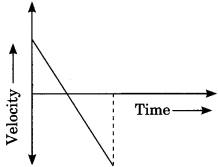
Question 7.
What is uniform circular motion? How is uniform circular motion regarded as an acceleration motion? Explain.
Answer:
When an object is moving in a circular path with a constant speed, the motion of an object is said to be uniform circular motion. When a body has a uniform circular motion, its velocity changes due to the continuous change in the direction of its motion. Hence, the motion of the body is accelerated motion.
Motion Class 9 Extra Questions Numericals
Question 8.
A person travels a distance of 4.0 m towards the east, then turns left and travels 3.0 m towards the north.
1. What is the total distance traveled by the person? North
2. What is his displacement?
Answer:
1. Total distance = OA + AB
= 4m + 3m
Total distance = 7m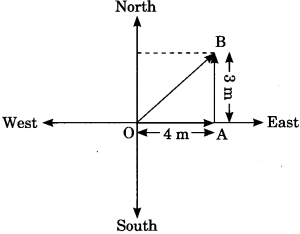
2. Total displacement = OB =
=
Displacement = 5 m
Question 9.
A person travels on a semi-circular track of radius 50 m during a morning walk. If he starts from one end of the track and reaches the other end, calculates the distance traveled and displacement of the person.
Answer:
Let the person start moving from A and reach B via O.
The distance travelled by the person
= Length of track = πr
=
Distance = 157.14 m
The displacement is equal to the diameter of the semi-circular track joining A to B via O.
= 2r = 2 x 50 m = 100m
∴ Displacement = 100 m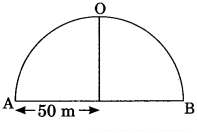
Question 10.
Dinesh takes 20 minutes to cover a distance of 5 km on a bicycle. Calculate his average speed in
1. m/s
2. km/h
Answer:
1. Average speed in metre/second
Distance travelled by Dmesh = 5 km = 5 x 1000 m = 5000 m
time taken (t) = 20 min = 20 x 60 seconds = 1200 seconds
2. Average speed in kilometre/hour
Average speed =
∴ Average speed = 15 km/h
Question 11.
A train starting from a railway station and moving with uniform acceleration attains a speed of 20 m/s in 10 seconds. Find its acceleration.
Answer:
Given,
initial velocity, u = 0 m/s
Final velocity, υ = 20 m/s
time taken, t = 10 s
Acceleration, a =
∴ a = 2 m/s2
Question 12.
A car moving with a speed of 72 km/h is brought to rest in 10 seconds by applying brakes. Find the magnitude of average retardation due to brakes and distance traveled by car after applying the brakes.
Answer:
Given, initial velocity = 72 km/h = 72 x
Final velocity = 0 m/s
Time taken = 10s.
1. Retardation
Acceleration, a =
a =
∴ Retardation = 2 m/s2
2. Distance travelled using equation, υ2 – u2 = 2as
(0)2 – (20)2 = 2 (-2)s
∴ s = 100 m
Question 13.
The velocity of a particle moving along a straight line in a certain time interval is shown below. What is the distance traveled during acceleration?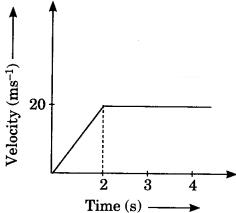
Answer:
Here particle accelerates for 2 seconds.
Distance traveled during acceleration = area under υ – t graph for 2 sec.
Question 14.
A girl walks along a straight path to drop a letter in the letterbox and comes back to her initial position. Her displacement—
The time graph is shown in the figure. Plot a velocity-time graph for the same.
Answer:
Velocity-time graph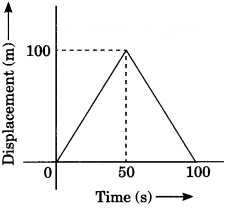
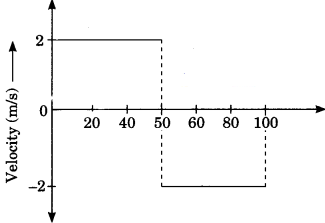
Question 15.
Obtain a relation for the distance traveled by an object moving with uniform acceleration in the time interval between the 4th and 5th seconds.
Answer:
Using equation, s = ut +
Distance travelled in 5 s; s1 = u x 5 +
s1 = 5u +
Distance travelled in 4 s; s2 = u x 4 +
s2 = 4u x 8a
Distance travelled in the interval between 4th and 5th sec.
= s1 – s1 = (5u +
∴ Distance travelled = u +
Motion Class 9 Extra Questions Short Answer Type 2
Question 1.
Draw a position-time graph of for
(a) rest
(b) uniform motion
(c) Non-uniform motion
Answer:
(a) Position – time graph for rest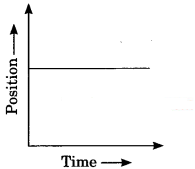
(b) Position – time graph for uniform motion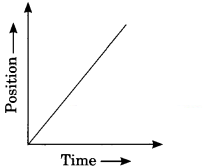
(c) Position – time graph for non-uniform motion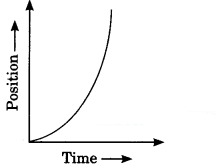
Question 2.
A draw velocity-time graph for
(a) Uniform motion
(b) Uniform acceleration
(c) Uniform retardation
Answer:
(a) Velocity – time graph for uniform motion (Const. speed)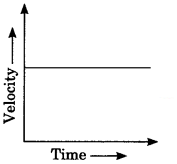
(b) Velocity – time graph for uniform acceleration (Const. acceleration)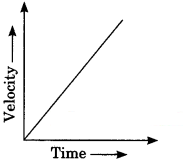
(c) Velocity – time graph for uniform retardation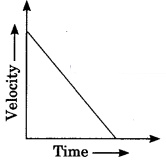
Question 3.
Explain the difference between the two graphs.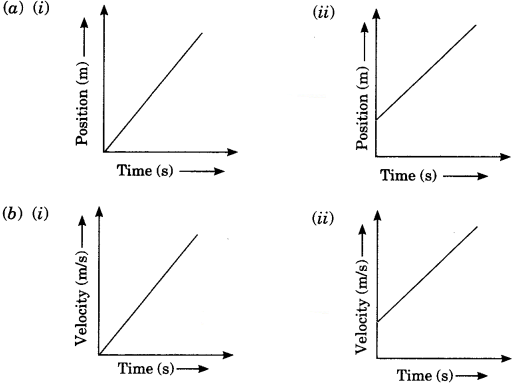
Answer:
(a) In the first graph, the body is starting its motion from origin but in the second graph, the body is starting its motion from any other point.
(b) In the first graph, the body has zero initial velocity but in the second graph the body has non-zero initial velocity.
Question 4.
Two stones are thrown vertically upwards simultaneously with their initial velocities u1 and u2 respectively. Prove that the heights reached by them would be in the ratio of
(Assume upward acceleration is – g and downward acceleration to be +g).
Answer:
The maximum height reached by the stone can be calculated by the formula
υ2 – u2 = 2as
Here, υ = 0 and a= – g
Applying this equation for the first ball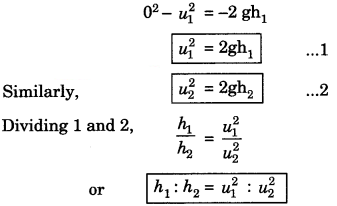
Motion Class 9 Extra Questions Numericals
Question 5.
Study the velocity-time graph of a traveling metro train as shown in the figure. What is the acceleration of the train
(a) during the first two seconds?
(b) between the second and tenth seconds?
(c) during the last two seconds?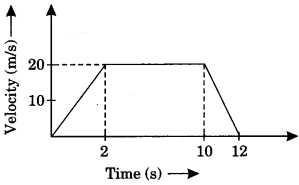
Answer:
(a) Acceleration, a =
Here, u = 0, u = 20m/s and t = 2s
a =
(b) Here, u = 20m/s, υ = 20m/s and t = 8s
a =
(c) Here, u = 20 m/s, u = 0 m/s and t = 2s
a = 0 – 20 = – 10 m/s2
Question 6.
An electron moving with a velocity of 5 x 10 ms1 enters into a uniform electric field and acquires a uniform acceleration of 10 ms2 in the direction of its initial motion.
1. Calculate the time in which the electron would acquire a velocity double its initial velocity.
2. How much distance would the electron cover in this time?
Answer:
Given, u =5 x 10 m/s2
a = 104 m/s2
1. From υ = u + at
take υ = 2u
2u = u + at
u = at
5 x 104 = 104 x t
∴ t = 5s
2. From s = ut +
s = 5 x 104 x 5 +
∴ s = 37.5 x 104 m
Question 7.
The motion of a train is described by the velocity-time graph as shown in the figure given below.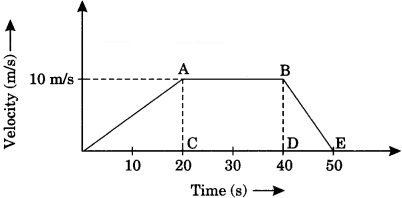
Find distance travelled by car between
1. 0 to 20 s
2. 20 s to 50 s
Answer:
Distance travelled = Area of velocity – time curve
1. For (0 to 20 s)
Distance = Area of ΔOAC =
2. For (20 s to 50 s)
Distance = Area of rectangle ABDC + Area of ΔBED
Distance = AC x CD +
Motion Class 9 Extra Questions Long Answer Type
Question 1.
Derive an expression for three equations of motion for uniform accelerated motion graphically.
Answer:
Equation of motion by graphical method
Let us consider a body is moving with acceleration where u is initial velocity and u is final velocity, s is the displacement of object and t is a time interval.
1. υ = u + at
We know that slope of υ – t graph gives acceleration so slope
= a =
a =
∴ υ = u + at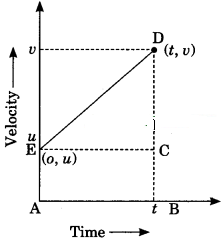
2. s = ut +
We know that area under u – t graph gives the displacement.
Area = s = area of triangle CDE + area of rectangle ABCE
s = ut +
Putting the value of υ – u
s = ut +
3. υ2 – u2 = 2as
We know that area under υ – t graph gives displacement
Area = s = area of trapezium ABDE
s =
Putting the value of t.
υ2 – u2 = 2as
Motion Class 9 Extra Questions HOTS
Question 1.
The distance-time graph of two trains is given below. The trains start simultaneously in the
same direction.
1. How much ahead of A is B when the motion starts?
2. What is the speed of B ?
3. When and where will A catch B?
4. What is the difference between speeds of A and B?
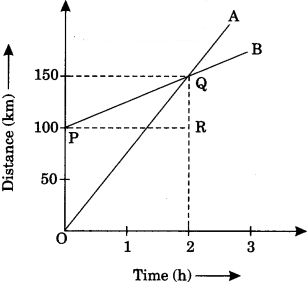
5. Is the speed of both the trains uniform or non-uniform? Justify your answer.
Answer:
- 100km
- Speed of B, υ =
x2−x1t =150−1002−0 = 25 km/h - After 2 hours, A catches B at 2. i.e.,150 km from origin 0.
- The slope of the distance-time graph of A is greater than that of B. Therefore, the speed of A is greater than
speed B. Speed of A = Slope of OQ =1502 = 75 km/h
Difference between speed of A and B =75 km/h – 25 km/h = 50 km/h - The speed of both trains is uniform.
Question 2.
A car starts from rest and moves along the x-axis with constant acceleration 5 ms2 for 8 seconds. If it then continues with constant velocity, what distance will the car cover in 12 seconds since it started from rest?
Answer:
Given,
u = 0, a = 5ms-2, t1 = 8s and t2 = 12s.
Total distance = distance travelled during acceleration + distance travelled during constant velocity
s = s1 + s2
For S1
s1 = u1t1 +
s1 =
s1 = 160 m
For S1
Applying υ = u + at
υ = 0 + (5 x 8)
u = 40 m/s
s1 = ut2
s2 = 40 x 12
s2 = 480 m
Total distance, s = s1 + s2
s = 160 + 480 = 640m
Question 3.
An object is dropped from rest at a height of 150 m and simultaneously another object is dropped from rest at a height 100 m. What is the difference in their heights after 2s if both the objects drop with the same acceleration? How does the difference in heights vary with time?
Answer:
At t = 0, difference in heights of two stones A and B
= 150 – 100 = 50 m
In t = 2s, distance through which each stone falls is –
s = ut +
∴ Difference in heights of two stones A and B
= (150 – 20) – (100 – 20) = 50
The difference in heights will remain the same at all times during their fall.
Question 4.
An object starting from rest travels 20 m in the first 2s and 160 m in the next 4s. What will be the velocity after 7s from the start?
Answer:
Given, the object travels 20 m first 2 s and 160 m in the next 4s.
From s = ut +
In first 2 s, s = 20 m
20 = 0 +
20 = 2 a
∴ a = 10 m/s2
Velocity at the end of 2s is υ = u + at
υ = 0 + 10 x 2 = 20 m/s
In next 4 s,
s = ut +
160 = 20 x 4 +
80 = 8 a’
a’ = 10 m/s2
Motion Class 9 Extra Questions Value Based (VBQs)
Question 1.
Sumeet and Jaikishan are close friends. Sumeet is a science graduate and Jaikishan is a commerce graduate. Sumeet finds that while driving on a clear highway, Jaikishan often exceeds the speed limit and argues that there is no harm in doing so when the road is clear. Sumeet does not agree with him and tells him that with an increase in speed, the stopping distance of the car would increase and he would not be able to manage if someone appears suddenly on the way.
Read the above passage and answer the following questions:
- is Sumeet right in his statement?
- What values are displayed by Sumeet in his statement?
- How is stopping distance related to the speed of the vehicle?
Answer:
- Yes, Sumeet is absolutely right.
- Sumeet is an intelligent boy and he can apply his knowledge of science in daily life.
- Stopping distance (velocity)2
Question 2.
Raju and Raman are close friends. One day they went for a picnic. Raju was driving the car. When Raman saw the speedometer, he found that the speed of the car was more than the allowed speed limit. Raman advised Raju to reduce speed to avoid the punishment of Overspeed.
Answer the following questions:
- What is the function of the speedometer?
- What values are displayed by Raman?
Answer:
- Speedometer provides instantaneous speed. B
- Raman is a careful and law-abiding person.
Question 3.
Three friends Ram, Mohan, and Roy have to reach point B from point A. The path taken by them is shown in the figure.
Answer the following questions:
- Distinguish between distance and displacement.
- If all of them travel at the same speed, who will reach first at point B and why?
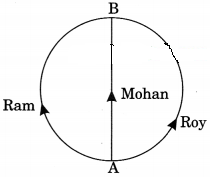
Answer:
1. Distance:
- It is the actual length of the path covered by a moving body.
- It is always positive or zero.
- It is a scalar quantity.
Displacement:
- It is the shortest measured distance between the initial and final positions.
- It may be positive, negative, or zero.
- It is a vector quantity.
2. Mohan will reach first as he is traveling the shortest path.



0 Comments